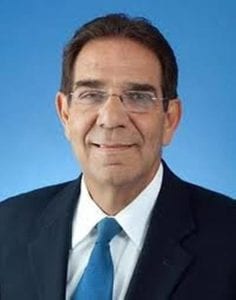
Political philosophers define the “Principle of Subsidiarity” as the idea that civic matters should be handled by the least centralized authority – in other words, by local government.

What this means is that, to the extent possible, matters like zoning, traffic management, street lighting, and community policing, should be handled by local jurisdictions such as cities, towns, and villages. In Miami-Dade County we have 34 municipalities, and they all yearn to be able to control such matters within their jurisdictions.
In the last week, I have received numerous calls from constituents in the cities of Coral Gables, South Miami, and Miami in regards to what should be one of the simplest matters to resolve, and that is the management of traffic through their jurisdictions, which can be done by traffic bumps and other calming devices. Let me elaborate on each of the three cities and their concerns, starting with…
Coral Gables
Led by Commissioner Vicente Lago, the City of Coral Gables has been clamoring for help in deterring and reducing the speed of traffic through their city. They had asked Miami-Dade County to install three “diverters” at three intersections immediately south of Bird Road and bordering on SW 57th Avenue. The county agreed to implement a pilot program (which lasted almost eight months), and then produced a report that panned the idea for a variety of reasons, including additional traffic experienced by streets immediately to the south of the ones closed off.
A sunshine hearing–cum-town hall meeting was held at Coral Gables City Hall. It was attended by almost the entire city commission, including its mayor, and myself. At the hearing we took testimony from residents (both for and against the diverters), and from county and city administrators. Perhaps the most frustrating thing of all was that there was no manual that prescribed the standards against which to measure the success, or lack thereof, for the diverters.
The discussion on that issue, led by Commissioner Michael Mena, elicited from county staff a troubling answer to the following simple question: Why has it taken so much time to have an inter-local agreement that specifies the standards to be applied? City and transportation officials were not able to answer with a simple response, and I soon learned that the lack of an inter-local agreement was a bigger problem than I had suspected. And that brings me to the biggest city of all and the one whose neighborhood stands between the biggest workplace (downtown) and the suburban areas. Let’s talk about the…
City of Miami
For about two and a half years now, I have been proposing to install traffic calming devices on SW 25th Street between Douglas and 32nd Avenue. This street is basically used as a speedway by folks who want to avoid congestion on Coral Way or US1. Even I have almost been run over a couple of times by cars that head east or west during commuting hours and reach speeds of 50 MPH or higher.
The neighbors were asked to do a petition drive, which they did. Those petitions were then delivered to the City and ultimately considered by the County. After much imploring, about a week ago a report reached my desk. Its findings will astound the reader.
Premised on a model created as an inter-local agreement with the City of Miami Beach, the County transit bureaucrats reported that this street does not meet the standards set in the only inter-local agreement in place, which happens to be in Miami Beach. Note that Miami Beach has no east-west rush hour traffic at all because the island is essentially a singular axis that goes north and south. (The causeways, of course, do provide east-west commuter access, but there are no surrounding neighborhoods that people can use to take a shortcut unless they happen to have handy a boat or jet-ski that would ferry them when there is too much congestion on the causeway.)
In effect, the County has told the oldest city in this metropolitan area (which goes back to the 19th century well before the County was even founded) that it cannot place calming devices, at its own expense, as petitioned by many of its citizens, because the County is using a model created for a totally different jurisdiction with totally different traffic issues.
I was pondering these disquieting revelations when I happened to call the Manager of South Miami (Steven Alexander) whose city also experiences enormous east-west cross-traffic during rush hour. That brings me to…
South Miami
In recent days, just as we were battling it out on the Coral Gables situation and the Miami anecdote above, the City of South Miami in the person of its Mayor (Phillip Stoddard) and its City Manager were discussing the very same problem.
South Miami has a peculiar configuration because it straddles US1 right at the point that 57th Avenue crosses that highway. This particular intersection is one of the most dangerous, complicated and often impassable intersections in all of Miami-Dade County. Knowledgeable commuters do their best to try to avoid this intersection altogether and try to go through the back streets of South Miami on the north side or use Sunset on the south side. Either way, the bedroom communities of South Miami are affected by excess traffic often exceeding any reasonable speed limit for what are otherwise very quiet residential neighborhoods.
Mayor Stoddard and Manager Alexander have been pleading with me to figure out a way for their city to have the authority to manage its own traffic.
That brings me to the global picture: The County’s delay in implementing the SMART plan. Despite the efforts of Chairman Bovo, Commissioners Moss, Levine-Cava and others on the county commission, the SMART plan that would alleviate east-west traffic is still in embryonic stages. We have just extended the ongoing Project Development & Environmental studies for another year – much to the dismay of many observers. An interim solution has been put forth involving extension of the City of Miami’s trolley service along the Flagler axis which has been embraced by City Commissioner Manolo Reyes and County Commissioners Joe Martinez and Javier Souto. Fortunately, the Commission as a whole unanimously approved a fare-free trolley service model to be used in unincorporated areas (which was approved on March 6).
It is incumbent upon all County Commissioners, Mayor Gimenez and the members of the TPO (which includes the mayors of our larger municipalities and the Chairwoman of the School Board, Perla Tabares Hantman) plus a state official, to expedite by all means necessary, and possible, additional rail and rapid-transit linkages as envisioned when the half-cent sales tax was approved in 2002.
The cities will not tolerate the County’s delays in implementing transit solutions while simultaneously prohibiting simple traffic management within their borders – paid for by themselves.
It’s about time that sanity prevails; that we return to the Principle of Subsidiarity; and that we allow the municipalities to solve their unique traffic dilemmas.
Miami-Dade County Commissioner Xavier L. Suarez can be reached at 305-669-4003 or via email at district7@miamidade.gov.







Comments are closed.